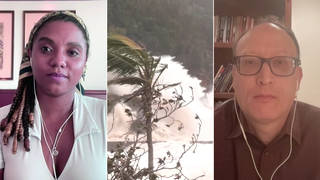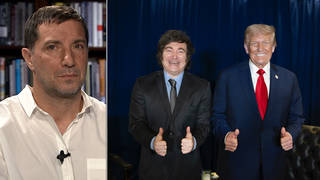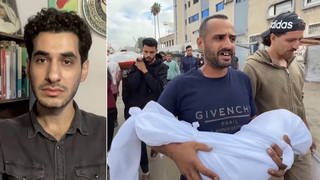
A Suez Canal service firm now says the huge container ship blocking the canal has been refloated and is on the move. The 200,000-ton ship, the Ever Given, got stuck on March 23, blocking one of the world’s most important trade routes, which is used for about 12% of all global trade. The impact of the canal shutdown has raised new questions about global trade practices, including the reliance on massive cargo ships, the conditions of workers on the vessels, and environmental degradation. “As years have gone by, the ships have gotten bigger and bigger and bigger,” says Laleh Khalili, professor of international politics at Queen Mary University of London. She notes that it was an earlier closure of the canal, during the Suez Crisis in the 1950s, that led shipping companies to build ever larger “megaships” like the Ever Given.
Transcript
AMY GOODMAN: This is Democracy Now!, democracynow.org, The Quarantine Report. I’m Amy Goodman.
Hopes are rising that the Suez Canal in Egypt may soon be reopened, after an enormous container ship blocked the canal and now has partially been refloated earlier today. The 200,000-ton ship, the Ever Given, got stuck six days ago, blocking one of the world’s most important trade routes. The waterway, which opened in 1868, connects the Mediterranean with the Indian Ocean. More than 450 other container ships are waiting to enter the canal, which is used for about 12% of all global trade. Some ships have opted to sail around the Horn of Africa instead of waiting for the Suez Canal to reopen.
The impact of the canal shutdown is already being felt. Syria has begun to ration fuel after a Syria-bound ship carrying oil was prevented from entering the canal. The crisis has also raised new questions about global trade practices, including the reliance on massive cargo ships. The Ever Given is almost as long as the Empire State Building is high. The ship’s cargo would extend for 75 miles if placed in a straight line.
We go now to London, where we’re joined by Laleh Khalili, professor of international politics at the School of Politics and International Relations at Queen Mary University of London. She’s the author of several books, including, most recently, Sinews of War and Trade: Shipping and Capitalism in the Arabian Peninsula. Khalili’s new piece for The Washington Post is headlined “Big ships were created to avoid relying on the Suez Canal. Ironically, a big ship is now blocking it.”
Hello, Professor. It’s great to have you with us. Can you start off by just describing what has happened in the Suez over this past week?
LALEH KHALILI: Hi, Amy. I’m very happy to be with you today.
So, the ship was obviously in a convoy heading north from the Red Sea to the Mediterranean, and it was carrying goods. It had — its point of origin was the Port of Ningbo in China, and it had made a couple of stops in Malaysia on the way to Europe. Its destination is Rotterdam. As it got into the ship, there were massive winds blowing across the canal. There are transversal winds blowing across the canal. And, of course, captains are quite experienced in trying to steer the ships, and one of the ways that they do this is by steering into the wind. I think, in this instance, perhaps it didn’t quite work out. And from what it seems like, that massive gust of wind resulted in the ship spinning a little bit. And that resulted, in turn, in hydrodynamic problems down below the ship. So the ship ended up getting diagonally wedged. Its prow got wedged in the east side of the canal, and its aft, or its stern, was on the west side of the canal. And so it essentially cut off all movement across the canal on Tuesday.
And since then, there’s been a lot of effort to try and refloat it. And part of the problem has been that it has lodged on the side of the canal. Part of the problem is that the canal is kind of a — its edges are not quite as deep as its center is. And so its being wedged at the front and the back in the side of the canal means that it needs to have dredgers dig the sand and the mud around it in order to release it, and then it has to be refloated down the center of the canal, pushed forward or towed forward to one of the lakes that are in the center of the canal, in order for the convoys to resume their movement across the Suez Canal.
AMY GOODMAN: The enormity of this ship, the Empire State Building on its side.
LALEH KHALILI: Yeah.
AMY GOODMAN: If you can talk about how ships got this large? And also, in the context of where it is right now, explain the significance and history of the Suez Canal and its importance in global trade.
LALEH KHALILI: So, the Suez Canal, as your listeners probably know, was actually dug by the French and the British in order to consolidate their imperial hold on Asia and Africa. So, that was intended to facilitate the connection between the Mediterranean and Asia and Africa. And when it was nationalized in 1956 by then-Egyptian President Gamal Abdel Nasser, the British, the French and the Israelis attacked the canal, and the canal was shut down because there was war debris and ships in there.
So, that is really interesting and ironic because, of course, that moment is the moment at which a lot of shipping companies — this was the height of global trade. There was lots of oil flowing from the Middle East to Europe, because, of course, this is the 1950s after the Second World War. Industry is again taking off in Europe. And so the canal was really crucial to these moments. And when it was shut down by that attack, the shipping companies started looking at ways to make the rounding of the Cape of Good Hope, the southern tip of Africa — make it more economically viable. And so the economies of scale dictated the creation of these megaships. And as years have gone by, the ships have gotten bigger and bigger and bigger, because this, of course, is much more profitable for shipping companies. So, it’s kind of ironic that these very large megaships that have been created have caused also the closure of the canal.
Now, in terms of what the canal does, the canal connects, of course, Asia and Europe. It’s the shortest strait between Asia and Europe. And part of the reason that it is so significant is because, as you mentioned earlier, 12% of global trade passes through it, but it’s one of the three most important routes, the other two being transatlantic and transpacific routes, for the movement of goods. Of course, as also your listeners know, China and East Asia, East and Southeast Asia, are now the factories of the world, and so a lot of manufactured good is produced there. And, of course, there is also the oil that flows not only northward, not only from the Middle East and the Gulf, but also, for example, Azeri oil or Kazakh oil that come from the Black Sea, and Libyan oil that comes from the Mediterranean, flows south to go to Asia. So, it’s still quite a significant artery of global trade.
AMY GOODMAN: Can you talk about the economic toll, overall, of what this means, and what you see happening next, a kind of reckoning taking place, or will there be?
LALEH KHALILI: So, I hope that there will be a reckoning. Usually such massive kind of issues that end up affecting global trade tend to have some after-echoes, although there have been other instances of ships having gotten stuck in the canal and being released, but none have taken as long as this one has.
Now, the reason that this is quite significant, obviously, the very first category of sort of the people who are hurt by this is the Egyptian government, that collects something like $700,000 per ship’s passage in the canal. So, if you’ve got 400 ships waiting to pass, it’s that much of the fees that the Egyptian government is not collecting from the Suez Canal.
There are, of course, other victims of this, if you will, and I think that those have often been forgotten. And those are the seafarers that are sitting on these ships. I think it’s really important to acknowledge — and vey few people have done — that seafarers have had some of the hardest months of work in the last year or so, because with the closure of ports and airports, they have been stuck on board ships sometimes for months after their contracts have ended, sometimes without being paid wages. And so, the fact that now, again, there are going to be delays, that they could potentially not be able to fly home at the time that they have, I think that it’s really important to acknowledge that they are, that they tend to — this has worked to their detriment in a great and major way.
And, of course, there are others, what we hear about. For example, just-in-time production of automobiles in Europe has been one of the categories of manufacturing that has been hurt by this. And, of course, clean gasoline that comes northward through the canal, there are going to be delays in the delivery of those. And so, there are a number of very specific categories of sort of manufacturing that have been affected.
One final thing is that — and we don’t know the exact — whether or not this is the case, but we also know that India is right now one of the world’s biggest pharmaceutical manufacturing locations, and we know that India is where a great percentage of the world’s various vaccines, COVID vaccines, are being manufactured. So, it is also possible that, of the ships that are awaiting passage through the canal, there might be some that are also carrying vaccines and are awaiting passage. So, the picture is going to be a lot more clear after the flow has started and we have a better sense of what cargo is being carried on the ships that have been delayed or ships that have had to be rerouted around the Cape of Good Hope. But at the moment, those are all the possible areas where there could be a delay, and there are people that have been hurt by that process.
AMY GOODMAN: I want to go to Osama Rabie, chairman of the Suez Canal Authority, speaking at a news conference Saturday.
OSAMA RABIE: [translated] Regarding the case of the accident, strong winds and sandstorm were not the main cause. And there might be technical failures and mechanical problems of the vessel or other human factors. But the specific reason has not been identified yet. Weather is only part of the complicated causes of the accident.
AMY GOODMAN: Can you respond to what he is saying? And then also talk about who owns this ship. What flag is flown on this ship?
LALEH KHALILI: So, I think the question of flags and ownership is really quite important, because it really affects the — who is going to be held responsible for this. So, the ship is actually owned by a Japanese company. It is operated by a Taiwan-based shipping company called Evergreen, which is one of the world’s biggest shipping freight carriers. But the ship itself is — and, of course, this has agents that are based in the Gulf, and it has ship management staff that are German. So it’s a kind of an international, if you will. It’s an international of different kinds of corporations.
But what is quite significant is that the ship flies the flag of Panama. Panama is what the International Transport Workers’ Federation considers to be a flag of convenience, or an open registry. Open registries are ship registries that allow for companies that are not necessarily based in Panama to actually register their ships there. And part of the reason that this is very inviting to a lot of companies is because there are — the regulations on labor and on environmental stuff is quite lax in the ship registries. The sort of requirements, the requirement thresholds for insurance, etc., are quite low. And taxation is — I mean, essentially, open ship registries are a kind of a subcategory of offshore havens, if you will. And, in fact, when they were first invented, the biggest sort of users of the ship registries were the Standard Oil of California and the banana boats of United Fruit. So, it has always been embedded in a kind of a capitalist accumulation, and it has always encouraged this kind of accumulation of capital without necessary accountability.
One of the things that is also significant about the flag of Panama is that your readers probably — your listeners probably remember that last year there was a ship that also grounded on the island of Mauritius, and there was a spillage of fuel on these incredibly sensitive, you know, environmentally sensitive areas. That ship was also flying the flag of Panama. And again, it becomes a question of who is going to be held accountable for this, and who is going to actually end up responding to this problem. Which? Is it going to be the owners? Is it going to be the ship’s operators? Is it going to be the flag of Panama which is responsible for investigating this? So, if anything that can come out of this process is if more scrutiny of these open registries, that would probably be a very important and a very good thing.
AMY GOODMAN: Professor Khalili, can you talk about the people on board this ship, the sailors, the workers, the working conditions on these massive ships?
LALEH KHALILI: So, I actually went down the Suez Canal a couple of times as part of my research in 2015 and 2016. And what is really striking is that in a ship that huge, which is essentially as big as a small town, you only have somewhere between 30 to 35 people working on the ship, which is an astonishing statistic, if you think about it — sometimes, actually, not even as many as that. But usually a container ship has a lot more people because, particularly if there are things like refrigerated containers, they have to make sure that the refrigerated containers continue to refrigerate, despite, for example, issues with fuel. There are, of course, people in the engine room that are maintaining these massive engines. And then, of course, there are the crew and the officers, who make sure that the ship is not rusted, maintain the ship. The officers, of course, are responsible for the ship’s arrival into and departure from ports, and, of course, steering the ship. The work aboard these ships, of course, requires enormous skill. And particularly the bigger the ship is, of course, it requires more skill. And the shipping companies tend to, obviously, hire people that have quite extraordinary abilities. They’re professionally astonishing.
But one of the things that has happened is that over the course of — since the 1970s and '80s, essentially, these ships — working conditions aboard the ships has become such that you have two layers of workers: You have the officers, and then you have the crew. And the officers nowadays, especially for ships that are flagged to Europe, tend to come from Eastern Europe. They tend to be cheaper. They receive lower wages than, for example, a German or a British officer or French officer. So they tend to come from — often from the former Yugoslavia. And the crew tends to come from the Global South. The two countries that provide the largest number of seafaring crews to the world are Philippines and China. And so, you have crew members that tend to come from the Philippines and China, and the contracts that they have tend to be quite long. So, the crew members are often on the ship for 11 months before they can fly home for a month or two to see their families. And so, this is also — as you can imagine, this is quite — you know, if they were to be going to go home soon thereafter, this is going to be a source of stress for them, because, of course, they're delayed by a week, and potentially longer than that. And so, the working conditions aboard the ships, you know, it is also a kind of a condition of possibility of the shipping. But it has a lot of tedium. It has a lot of hard work. It has a lot of skills. But it has a lot of also anxiety associated with it.
AMY GOODMAN: I wanted to end on a different issue, Laleh Khalili, and that is a piece that you just wrote about, talking about U.S.-China relations, in the London Review of Books, titled “Growing Pains: The Emperor’s New Road: China and the Project of the New Century.” On Friday, President Biden told reporters he discussed plans with British Prime Minister Boris Johnson to counter China’s massive Belt and Road Initiative.
PRESIDENT JOE BIDEN: One of the things I suggested we do is — we talked about China and the competition they’re engaging in, in the Belt and Road Initiative. And I suggested we should have, essentially, a similar initiative coming from the democratic states, helping those communities around the world that in fact need help.
AMY GOODMAN: Professor Khalili, your response?
LALEH KHALILI: So, it’s quite interesting, because it seems to me that the U.S. military-industrial-diplomatic complex has always wanted another enemy. And it benefits from having another cold war going. And so, to cast China’s provision of, for example, infrastructures in order to facilitate its trade seems to be a kind of an encouragement of this. Of course, there are lots of problems also associated with China’s Belt and Road Initiative. For example, in some of the places that these investments are happening, there are all sorts of human rights abuses happening, including in China’s own Xinjiang.
AMY GOODMAN: And briefly explain the Belt and Road Initiative, which is not explained at all in the media in the United States very much.
LALEH KHALILI: So, the Belt and Road Initiative is, essentially, a plan that was put into action in 2013 to actually gather under its title a whole lot of already existing infrastructure projects across the Asian, Eurasian landmass, all the way through Europe, for infrastructure, and particularly transport projects, so high-speed rail, train lines that went through different terminuses and would, for example, end up in Singapore, in Iran and in Budapest, and then, across the oceans, the South China Sea and the Indian Ocean, and through the Mediterranean, essentially, a route for ships, so investments in port and maritime infrastructures. And so, this was called the maritime belt and maritime — the land belt and the maritime road.
And so, essentially, this massive program entailed investment, financing by China, close, actually, to how much — $400-and-something billion, close to actually what the World Bank had invested in that period of time on infrastructures. And part of the reason for this, of course, is that many of these countries did need infrastructures, and they’re often not given it because of sanctions or because of U.S. foreign policy or because of, of course, histories of European colonization of a lot of the places that are destinations for this investment.
And so, this is essentially the Chinese Belt and Road Initiative. Of course, it facilitates Chinese capital accumulation. It’s not done out of Chinese goodness. And, as I said, it does also have, in areas — for example, in Balochistan and Pakistan or in various provinces in Myanmar or, indeed, in Xinjiang, there are issues associated with this. But it’s also the way that it is being cast. The way that it’s being addressed in Europe and North America is as if China is sort of the next great enemy.
It’s really important also to point out that China, despite sort of this expansion, has not, for example, established — I don’t know — 800 military bases, like the U.S. has done in lots of different places, but, rather, it does have one or two military bases outside of its own periphery, but it also depends on private military companies. So, it’s quite an interesting moment, because, essentially, what China is doing is the enforcement of capitalism with a Chinese face, if you wish, but it is seen as a threat to the U.S. national security, perhaps because, as I said, a cold war is always good for the military business in the U.S. and Europe.
AMY GOODMAN: Well, Laleh Khalili, we want to thank you for being with us, author of Sinews of War and Trade: Shipping and Capitalism in the Arabian Peninsula. And we’ll link to your piece in The Washington Post, “Big ships were created to avoid relying on the Suez Canal. Ironically, a big ship is now blocking it.” Professor Khalili teaches international politics at the School of Politics and International Relations at Queen Mary University of London.
When we come back, we’ll speak with UCLA professor Robin D.G. Kelley about the historic Amazon unionization drive and the history of radical Black organizing in America. We’ll also talk about the first day of opening arguments of the Derek Chauvin trial. Stay with us.












Media Options